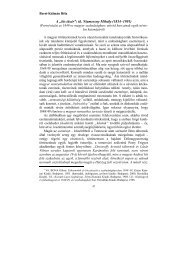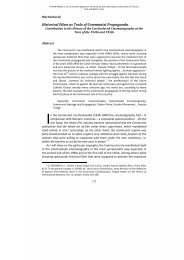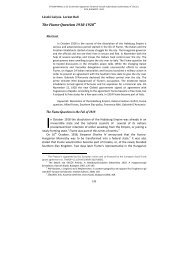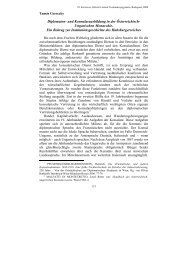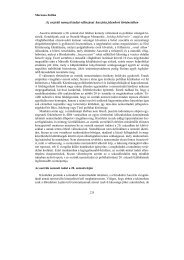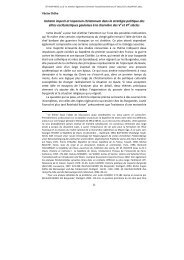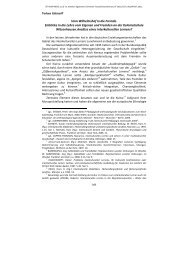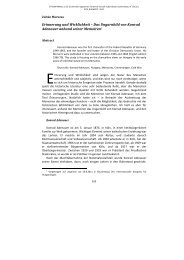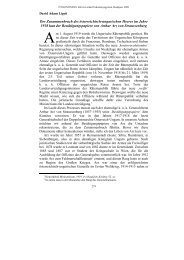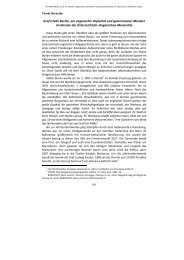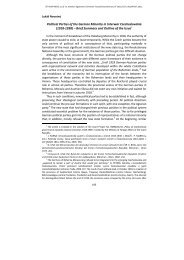The Molotov-Ribbentrop Pact - ELTE BTK Történelem Szakos Portál
The Molotov-Ribbentrop Pact - ELTE BTK Történelem Szakos Portál
The Molotov-Ribbentrop Pact - ELTE BTK Történelem Szakos Portál
You also want an ePaper? Increase the reach of your titles
YUMPU automatically turns print PDFs into web optimized ePapers that Google loves.
Grether, Sandra<br />
Pogroms in Eastern Poland after the German Occupation<br />
<strong>The</strong> Reich‘s attack on the Soviet Union in 1941 broke the treaty both<br />
countries had signed just two years earlier, guaranteeing each other neutrality<br />
and secretly dividing Eastern Europe into two areas of interest, the so-called<br />
Hitler-Stalin-Pakt, or, more accurate, Molotow-<strong>Ribbentrop</strong>-Pakt. 1 Following<br />
roughly sketched borderlines, the territory of the Second Polish Republic was<br />
divided between the two partners in mutual interest - and left it to further<br />
negotiations whether these regions were to be incorporated into the Reich and<br />
the Soviet Union or to be given some state of independence. <strong>The</strong> Hitler-Stalin-<br />
Pakt had guaranteed the Reich the Soviet Union‘s neutrality in case of its attack<br />
on Poland, which took place only a couple of days after the signing and was<br />
followed by the invasion of Soviet troops into the Eastern parts of the country<br />
within two weeks. Both countries installed regimes in their respective zones of<br />
former Poland, forming them according to their plans and also forming the<br />
people living in these regions. In 1941 the Wehrmacht thus first conquered<br />
territories that had been occupied by the Red Army in 1939 in accordance with<br />
the Pakt and the Eastern Polish people‘s reaction to the invasion were in large<br />
parts due to their treatment by the Soviet occupants.<br />
One especially prominent phenomenon in this context is the willingness<br />
locals showed in taking part in German units‘ atrocities against Jews. With<br />
German soldiers arriving, Poles, Ukrainians and White Russians unleashed<br />
pogroms against their Jewish neighbours, often triggered by German units, but<br />
more often without. <strong>The</strong>ir motivation has been the basis of a widespread<br />
discussion a few years ago, initiated by Bogdan Musial. 2<br />
<strong>The</strong> events leading to these pogroms and the question why the Jewish<br />
population of Eastern Poland fell victim to their neighbours in June and July of<br />
1941 was the basis for a presentation I gave in December 2009 as part of a<br />
conference on the Molotow-<strong>Ribbentrop</strong>-Pakt and is the basis for this paper. I<br />
would like to show how the Soviet occupation of Eastern Poland 1939-1941<br />
deepened contradictions within the local societies and how these tensions led to<br />
anti-Semitic riots once the Red Army left and the German armies approached.<br />
As this paper‘s main focus of interest are events in the summer of 1941, the<br />
German occupation of Poland from 1939 on as well as developments after the<br />
German invasion of the Soviet Union will only be taken into account when of<br />
1 Non-aggression treaty between the Reich and the Soviet Union („Nichtangriffsvertrag zwischen<br />
Deutschland und der Union der Sozialistischen Sowjetrepubliken”), 23rd August 1939, cited from<br />
http://mdzx.bib-bvb.de/cocoon/1000dok/dok_0025_pak.html?object=translation&lang=de, 19.3.2009.<br />
I will use the term Hitler-Stalin-Pakt because it is more common.<br />
2 MUSIAL, Bogdan: „Konterrevolutionäre Elemente sind zu erschießen” - Die Brutalisierung<br />
des deutsch-sowjetischen Krieges im Sommer 1941. Berlin 2001.<br />
169



